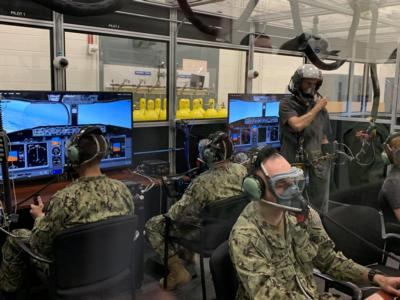Thu, Jun 10, 2021
Former Methods Often Caused Decompression And Barotrauma Sickness
The Naval Aviation Training Systems and Ranges program office (PMA-205) Normobaric Hypoxia Trainer (NHT) team recently designed, delivered, installed, and began support of the NHT at Naval Air Station (NAS) Patuxent River, the first trainer of its kind eliminating common hypoxia training injuries.

The legacy Low Pressure Chamber trainer used in hypoxia training for pilots and aircrew often caused decompression and barotrauma sickness, the leading causal factors for training injuries in the Naval Aviation Survival Training Program (NASTP). The NHT team, made up of an expert group of research engineers and scientists, looking to mitigate those injuries, developed the NHT concept.
“With the critical and innovative work of our NHT team, we no longer need to worry about barotrauma during cold and sinus season that caused trapped gas pain and injury in our fixed wing non-ejection seat aircrew students at the Aviation Survival Training Centers,” said Cmdr. Andy “Lurch” Hayes, NASTP integrated project team lead. “Inside safety observers no longer need to administer nasal decongestants or perform the invasive Politzer maneuver to inflate the middle ear and sinuses by injecting compressed air up one nostril while the other was closed.”
The NHT design not only eliminates the risk of barotrauma and decompression sickness, but it also can simulate high altitude flight while accommodating up to 12 personnel including six aircrew and two pilot/co-pilot teams monitored by two inside observers. Borrowed from the success of students trained on the Reduced Oxygen Breathing Device, the team included flight simulators and controls to add realism and allow aircrew to practice Emergency Procedures (EP) specific to their Naval Air Training and Operating Procedures Standardization aircraft. This is the first time in naval aviation history that fixed wing non-ejection seat pilots are able to practice EPs in a state of hypoxia.
“Gone are the days of patty cake in the chamber to monitor hypoxia symptoms. We are fortunate to have the aviation physiology expertise on our team that creatively developed a training system that allows the aircrew to experience hypoxia in a safe environment while conducting aviation operator tasks,” said Capt. Lisa Sullivan, PMA-205 program manager.
More News
Ultrahigh Frequency (UHF) The frequency band between 300 and 3,000 MHz. The bank of radio frequencies used for military air/ground voice communications. In some instances this may >[...]
During The 7 Second Descent, There Was Another TAWS Alert At Which Time The Engine Remained At Full Power On October 24, 2025 at 2115 mountain daylight time, a Cirrus SR22T, N740TS>[...]
From 2009 (YouTube Edition): Educational Organization Aims to Inspire by Sharing Tuskegee Story Founding leader Don Hinz summarized the Red Tail Project’s mission in simple, >[...]
“This feels like an important step since space travel for people with disabilities is still in its very early days... I’m so thankful and hope it inspires a change in m>[...]
Also: New Katanas, Kern County FD Training, IndiGo’s Botched Roster, MGen. Leavitt Named ERAU Dean The Australian Transportation Safety Bureau (ATSB) has wrapped up its inves>[...]
 ANN's Daily Aero-Term (12.19.25): Ultrahigh Frequency (UHF)
ANN's Daily Aero-Term (12.19.25): Ultrahigh Frequency (UHF) NTSB Prelim: Cirrus Design Corp SR22T
NTSB Prelim: Cirrus Design Corp SR22T Classic Aero-TV: The Red Tail Project--Carrying the Torch of the Tuskegee Airmen
Classic Aero-TV: The Red Tail Project--Carrying the Torch of the Tuskegee Airmen Aero-News: Quote of the Day (12.19.25)
Aero-News: Quote of the Day (12.19.25) Airborne 12.17.25: Skydiver Hooks Tail, Cooper Rotax Mount, NTSB v NDAA
Airborne 12.17.25: Skydiver Hooks Tail, Cooper Rotax Mount, NTSB v NDAA



